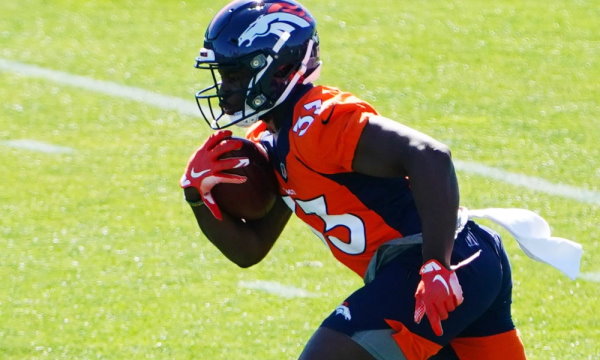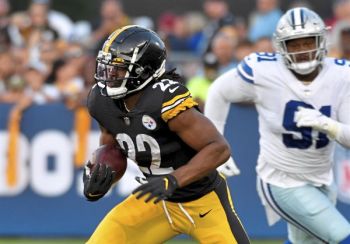Welcome back to the Rookie Report! Football season is fast approaching – we’ve gotten our first taste of preseason action, and while the games haven’t exactly been barnburners it was still nice to see actual football again. Today I’m continuing my preseason look at the rookie class. If you missed my QB fact sheet, you can find that here, but today I’m going to take a look at the running back class. The premise is simple. I’m going to give you some cold hard facts that apply to the rookie running back class based on things like draft capital, college production, and coaching tendencies, and then give you my interpretation of what those things mean for 2021 season and beyond. Since most dynasty rookie drafts are over, the info is going to slant towards redraft leagues, but there will be some dynasty tidbits thrown in as well. Let’s dive in…
FACT:
Since Mike Tomlin took over as Steelers head coach in 2007, their lead running backs have averaged 275.6 touches per year.
In the last 10 years, the 14 running backs drafted in the 1st round of the NFL draft have handled an average of 240 touches in their rookie year.
What it means:
Najee Harris should be in line for a huge role as a rookie. 10 of those 14 first-round picks handled at least 200 touches in their rookie season (and Christian McCaffrey was at 197), and Harris landed with one of the teams that aren’t afraid to use a workhorse back. Only 5 teams have given more touches per year to their lead back over Tomlin’s tenure than the Steelers. All camp reports so far have confirmed that Najee is ticketed for a big role and his 43 catches as a senior makes it easy to envision him being very involved in the passing game. Harris has the upside this year to finish as a top-8 back and should be THE guy in the Pittsburgh backfield for the foreseeable future.
FACT:
From 2017-2020 there were 5 running backs drafted in the 2nd round of the NFL draft that had a teammate who was both, a former 1,000-yard rusher, and was 28 years old or younger. 4 of those 5 handled 14+ touches per game as a rookie (AJ Dillon is the only one who didn’t), and three of them finished as the RB16 or better in points per game (half-PPR) as a rookie.
Nick Chubb narrowly missed the cutoff for this list when he was drafted in 2018. Carlos Hyde was 27 years old at the time and his career-high in rushing yards at that point was 988 yards. Chubb averaged 13.25 touches per game and finished as the RB16 in total points as a rookie.
What it means:
You might’ve guessed that the only running back in the 2021 class this applies to is Javonte Williams. Williams is being drafted as the RB24, while teammate Melvin Gordon is being drafted as the RB28. I don’t believe that Gordon is washed up, and I don’t think he’s going to just be pushed aside for Javonte, but those ADPs are too close together. From 2001-2010, there were 30 running backs drafted in the first round. From 2011-2020, that number was just 11. A second-round running back today is the equivalent of a mid-to-late first-round running back a decade ago, and a player with that kind of draft capital is going to see the field a lot.
Williams posted 1,445 scrimmage yards and 22 TDs in just 11 games while splitting the RB work pretty much right down the middle with Michael Carter last season at North Carolina, and his physical running style should play well in Denver. Williams doesn’t profile as a prolific pass-catcher, so he’ll be most valuable in non-PPR leagues, but don’t be afraid to reach above his ADP for him in any format. You may have to wait a few weeks for Williams to be fully unleashed like people had to with Nick Chubb in 2018, but he’s going to be a solid RB2 and maybe more once he gets the starter’s share of the work.
FACT:
In his time as a college coach, Urban Meyer had 4 different seasons where a wide receiver or tight end logged 70+ rushing attempts.
What it means:
There’s a reason the Jaguars drafted Travis Etienne in the first round of the NFL Draft despite having an established starting running back in James Robinson. Urban has a propensity to use his most dynamic players in a hybrid running back and wide receiver role if they can handle it. He showed hints of it at Utah when his leading receiver Paris Warren totaled 48 rushing attempts in his two seasons there, and in later years went all-in on that role with Percy Harvin (twice), Trey Burton, and Curtis Samuel. Etienne appears to be ticketed for that type of role with the Jaguars.
This is a great thing for Etienne’s outlook as a rookie, especially in PPR formats. James Robinson figures to still be the leading rusher, but Etienne should be heavily involved in the passing game. I already mentioned above that 1st-round running backs have averaged 240 touches as rookies over the last decade. I don’t think Etienne will approach that number, but I’d view him as a rich man’s Nyheim Hines (or Duke Johnson from a few years ago). He should probably be drafted as a borderline RB2 in full PPR leagues, and about 6-8 spots lower in non-PPR formats.
FACT:
Kyle Shanahan has been an offensive coordinator or head coach for 13 seasons. In 7 of them, his lead back logged 200 or fewer touches. In 6 of them, his lead back logged more than 280 touches. None of his lead backs finished between those two numbers.
What it means:
Shanahan typically either has a clear-cut number one back or a full-blown committee backfield. There hasn’t been any in-between for him. For the last 3 seasons in San Francisco, it’s been the committee, and this year looks to be more of the same with a crowded backfield group that includes Raheem Mostert, Wayne Gallman, and rookies Trey Sermon and Elijah Mitchell. That doesn’t even include Jeffery Wilson Jr., who should return from injury somewhere in the back half of the season. Sermon is someone who has been identified as a sneaky later-round pick that has starter upside, but I don’t expect his usage to be consistent enough for that to come to fruition.
The 49ers have had an efficient run game under Shanahan, but I expect a carousel of running backs to be involved, with Mostert and Sermon handling the biggest share of the load. They’ll both have their weeks where they produce, but you’ll be hard-pressed to guess which one it’ll be unless there are injuries involved. I wouldn’t reach for Sermon expecting a starter’s workload, but I wouldn’t avoid him at his current ADP either (RB37).
FACT:
Since 1990, only 7 undrafted running backs have run for 800 yards as a rookie.
What it means:
After the success of James Robinson last season, I’ve seen a few fantasy articles asking – who’s next? Who is the next James Robinson? The answer is probably no one. Aside from Robinson last year, and Phillip Lindsay in 2018, no undrafted rookie has finished as an RB1 since Dominic Rhodes in 2001. There has been some camp hype for Javian Hawkins in Atlanta and to a lesser extent Jaret Patterson in Washington. Patterson is buried on the depth chart and should be avoided in all but the deepest of leagues. Hawkins is the one UDFA who may be worth a dart throw in more standard leagues, but it’s a longshot that he amounts to much this year. There’s no guarantee he beats out Qadree Ollison for the RB2 role. If you take Hawkins in a dynasty league and he does hit as a rookie, you should look to flip him when you’re able. In the last 30 years, only Ryan Grant and Chris Ivory have posted three 800-yard rushing seasons as a UDFA, and no one has posted a 4th.
FACT:
In the last 5 seasons, the average RB24 has scored 167.4 PPR points. Since 2000, only 5 running backs out of 287 that were drafted in the 4th round or later topped that point total as a rookie. 4 of them topped 225 PPR points.
What it means:
Drafting a day 3 running back and hoping for anything more than RB3 production is a losing proposition. One silver lining here is that the guys who have succeeded as rookies have hit big, and they’ve had one thing in common that can help identify them. Aside from Mike Anderson (who had injuries to both Terrell Davis and Olandis Gary in front of him) all the running backs who finished with more than 167 PPR points as rookies landed in wide-open backfields that didn’t have prior fantasy success. The four running backs were Domanick Williams, Jordan Howard, Alfred Morris, and Zac Stacy, and not one of them entered their rookie season with a single teammate that had previously finished as even a top-40 fantasy back.
The problem is there aren’t any day 3 backs this year that fit that criteria. The closest to it would be Jake Funk – Darrell Henderson finished as the PPR RB36 last year – but I wouldn’t count on Funk to unseat Henderson. You shouldn’t be jumping ahead of ADP to take Michael Carter, Kenneth Gainwell, or Chuba Hubbard unless an injury (CMC or Miles Sanders) or cut (Tevin Coleman) happens unexpectedly.
FACT:
During Bill Belichick’s tenure as head coach (2000-2020) the Patriots drafted 13 running backs in the NFL Draft. Those players have combined for just 3 seasons as the PPR RB24 or better.
What it means:
The Patriots have been wildly unsuccessful at drafting running backs during the Belichick era. James White has been easily the most successful back they’ve drafted in that time, with one top-10 season and two top-20 seasons in his career. It doesn’t instill much confidence in the long-term outlook for Rhamondre Stevenson. His skill set has been compared to LeGarrette Blount, which is exciting to consider when you remember that Blount scored 18 touchdowns in a season with New England, but the Patriots have a long track record of relying on a committee backfield that makes it hard for anyone to stand out in fantasy without a crooked touchdown total or a crooked reception total. In dynasty leagues, you’d probably be best served by avoiding Stevenson. If you’ve already drafted Stevenson you should look to trade him on the strength of his two-touchdown preseason debut.
That’s all I’ve got for the running back class for now. Hopefully, it helps give you a little clarity on how you should be treating them in your fantasy drafts. I’ll be back with a look at the rookie tight ends and wide receivers soon, but in the meantime feel free to hit me up on Twitter and let me know if you want to yell at me about anything written above (@Shawn_Foss). As always: good luck, trust your gut, and have fun. It’s just a game.


